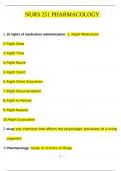NURS 251 PHARMACOLOGY
1. 10 rights of medication administration: 1. Right Medication
2. Right Dose
3. Right Time
4. Right Route
5. Right Client
6. Right Client Education
7. Right Documentation
8. Right to Refuse
9. Right Reason
10.Right Evaluation
2. drug: any chemical that affects the physiologic processes of a living
organism
3. Pharmacology: study or science of drugs
,4. Pharmaceutics: The science of preparing and dispensing drugs,
including dosage form design.
5. Enteral dosage forms: Tablets, capsules, oral soluble wafers, pills,
timed-release capsules, timed-release tablets, elixirs, suspensions,
syrups, emulsions, lozenges or troches, rectal suppositories, sublingual
or buccal tablets
6. Parenteral Dosage Forms: Injectable forms, solutions, suspensions,
emulsions, powders for reconstitution
7. Topical dosage forms: Aerosols, ointments, creams, pastes, powders,
solutions, foams, gels, transdermal patches, inhalers, rectal and vaginal
suppositories
8. Pharmacokinetics: study of what the body does to the drug and the
study of ADME
9. ADME: absorption, distribution, metabolism, excretion
10.Pharmacodynamics: the study of the biochemical and physiological
,interac- tions of drugs at their sites of activity.
11.Pharmacotherapeutics: The treatment of pathologic conditions
through the use of drugs
12.Pharmacognosy: The study of drugs that are obtained from natural
plant and animal sources.
13.Pharmacogenetics: the study of the influence on genetic factors on
drug re- sponse
14.Toxicology: The study of poisons, including toxic drug effects, and
applicable treatments.
15.Pharmacoeconomics: The study of economic factors impacting the
cost of drug therapy.
16.3 types of drug names: chemical, generic, trade
17.chemical drug name: Describes the drug's chemical composition and
molecu- lar structure
, 18.Generic drug name: official, nonproprietary name for the drug
19.Trade drug name: also known as brand or proprietary name. This is
the name under which a manufacturer markets the medication.
20.Enteral route - absorption: the drug is absorbed though the mucosa
of the stomach, small intestine, or large intestine
21.Parenteral Route: any where other than the gastrointestinal tract -
commonly refers to injection
22.Topical Route: application of drugs directly to body surfaces - skin,
eyes, ears, nose, lungs, rectum, vagina
23.Inhalation route: inhaled drugs are delivered directly to the lungs as
microme- tre-sized drug particles
24.Absorption: the movement of a drug from its site of
administration into the bloodstream for distribution to tissues
25.Distribution: transport of a drug by the blood stream to the drugs site
of action




